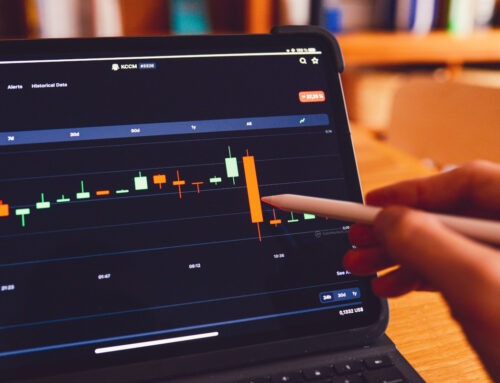Are you looking to learn about the various swing trading options strategies? If so, you’ve come to the right place. This in-depth guide will take you from knowing absolutely nothing about swing trading options strategy to a confident, prepared state. By the end of this article, you’ll be ready to start swing trading with options.
This approach to investing unlocks possibilities that traditional stock trading does not. You can incorporate options into your existing strategy as a way to gain higher profits or to hedge risk. But, there’s no doubt about it – options trading can be pretty complicated at first. Don’t worry – we’re going to simplify it for you. Let’s start with a quick breakdown of options.
Featured Courses:
What Are Options?
In the stock market, options are contracts that can be bought and sold. This asset class offers all sorts of advantages that set them apart from stocks and ETFs. Options are defined as a contract that gives the buyer the right to buy or sell a predetermined amount of some asset (gold, cattle, you name it) at a predetermined price. There is typically a predetermined date by which the bearer of the option must exercise their rights – after a certain point, the option becomes void.
There are a few situations that occur with options: the most desirable is that the price of the security you bought an option for goes up before the exercise date. You can exercise the option and buy the security at a lower price to earn a profit. Or, the less desirable outcome: the price of the security drops tremendously, and you’re stuck with an option to buy the security at a much higher, predetermined price.
A key takeaway is that options are not obligatory from the buyer’s standpoint. But that doesn’t mean these derivatives don’t come with their own risks – we’ll cover these later on. First, let’s talk about calls and puts.
Call Options vs Put Options
There are two main types of options – calls and puts. A call option is the one we discussed above: you have the right to buy a security, but not the obligation. A put, on the other hand, gives you the right to sell a security at a set price – but not the obligation. Calls and puts are the exact opposite of each other. To help you remember which is which, think of it this way:
- A call option gives you the ability to call the security towards you (buy)
- A put option gives you the ability to put a security out into the market (sell)
So, what do these types of options look like in the trading world? Let’s break it down:
What Buying Call Options Looks Like
When you buy a call on the stock exchange, you are purchasing a contract with a pre-determined asset, price, and date. When would you do this? Well, if you anticipate the price of the underlying security is going to rise prior to expiring – you stand to gain a profit by locking in a lower price.
Say you bought a 6-month call option for 1,000 shares of a specific stock at $20/share. By the 5th month, the price of that stock had risen to $35. You can exercise your call option to essentially buy 1,000 stocks at a discount. From there, you can hold the investment long-term or flip it for a quick profit.
However, the stock’s price could also fall – say it drops to $10 before the six months is up. In this case, you would not want to exercise your call option as you would be buying an overpriced asset (relative to the current price on the market). You would lose on this investment.
What Buying Put Options Looks Like
What about a put option, though? Let’s look at another scenario. Say you buy a put option under the same terms above, for the same stock. Here, you’re hoping the price drops on that stock before the 6 month expiration date. In this scenario, you then have the right to sell that stock at the higher price point you secured.
On the flip side, if the price goes up before the options expiration date – you’d be stuck selling the stock at a discount or not exercising your option, essentially losing the investment.
Can You Swing Trade With Options?
Now that you know the basics of options, how do they relate to swing trading? Can you swing trade with options? The answer is yes!
These contracts come with an expiration date. But that doesn’t mean you can’t exercise your options in accordance with a short-term swing in a price within 2-3 days of purchasing your contract. In the US, you can exercise options at any point before that expiration date. That means that you stand to gain huge profits by securing an options contract and exercising it in accordance with a stock’s price swinging up or down, depending on the option you buy. Keep in mind – European options are a little different. You can only exercise your option on that expiration date.
With that said, there are quite a few benefits of developing a swing trading options strategy. There are also a few drawbacks to this strategy. Let’s take a look.
What Are The Benefits & Drawbacks Of Swing Trading Options?
Besides the obvious one – the potential to gain huge returns from an option swinging in your favor – there are a few other noteworthy benefits of implementing swing trading options strategies. A second benefit is that you can leverage options as a way to help limit your risk exposure.
But the third benefit of swing trading options is that it can be very cheap. If you’re trading a small account, you may want to consider making options part of your swing trading strategy. You’ll be able to stretch your capital further.
Now, we know what you’re thinking – are there any drawbacks or risks to swing trading options? Yes. This approach is not without a few cons. If you buy an option for a given stock, and that stock’s price remains stagnant – the option you purchased loses value each and every day without change. The closer you get to the expiration date without price movement in your favor, the less your contract is worth.
How To Implement Your Swing Trading Options Strategy
Ready to learn how to implement options into your trading strategy? It’s not as complicated as it may seem – especially when you have the right tools in your arsenal. First things first – you need to pick an asset you want to trade.
Choose A Stock or Security
The first step in options swing trading is determining which stock or security you want to purchase a contract for. Maybe you know the ins and outs of the agriculture industry, and you have a really good idea of how the price of walnuts, cattle, or some other derivative will trend over the next few weeks. Or, perhaps your technical analysis for a given stock leads you to believe that a price reversal is rapidly approaching. In either of these situations, there is a good opportunity to swing trade options.
Determine Whether You Want To Purchase A Call or Put
Once you’ve determined which stock or security you want to purchase a contract for, which side are you going to fall on – will you purchase a call or put? This will depend on which direction you think the stock or commodities price is going to go. If you anticipate the price is going to rise, you would buy a call option. This would allow you to buy that stock or commodity at a discount should your speculation pay off.
On the flip side, if you have reason to believe the price is going to drop – you’d but a put option. This will give you the ability to sell the stock or commodity at a higher price than available on the market.
Pick The Exercise Price
One of the biggest factors that determine how much your options contract costs is the agreed-upon exercise price. This is a part of swing trading options strategies that can get a bit complicated, so allow us to explain.
Your exercise price, also known as the strike price, is the price point that you will ultimately buy or sell your stock or commodity at. When you buy a call, you hope the market price exceeds your strike price – so you can buy at a discount. When you buy a put, you hope the market price goes below the strike price – so you can sell at a premium.
So, how do you determine the exercise price? There are three options: in the money, out of the money, or at the money. An in-the-money exercise price is one that’s better than the current market price. An out-of-the-money exercise price is one that is worse than the current price. And, an at the money exercise price is – you guessed it – right at the current market price.
When it comes to swing trading, you’ll typically see traders purchase options with stock prices at the money or just out of the money. They’ve usually conducted some form of technical analysis that leads them to believe that within a short period of time (a few days to a few weeks), their contract will end up in the money so they can earn a profit.
Determine The Expiration Date
Along with the exercise price, the expiration date will affect how much you have to pay for your contract. It will also affect the value of your contract as time goes on. Typically, the longer the expiration date, the more expensive your options contract will be. But, they also limit your risk – as there is more time for the price to swing in your favor.
However, swing traders typically trade options with shorter-term expiration dates – sometimes as short as one month. After all, the basis of swing trading strategy is to capitalize on short-term swings and secure profits within a few weeks of opening a position. You’ll follow the same strategy when swing trading options. Keep in mind, though – a shorter expiration date presents more risk. You’ll need to be confident in your belief that the price is going to swing quickly.
Purchase Your Contract & Manage Your Position
Now comes the fun part. Once you purchase your contract, you are then tasked with managing your position effectively. This means monitoring charts and setting up technical indicators to help you determine when the right time to execute your options is. Set alerts for the price at which you’ll exercise your options.
The nice thing about options trading is that your risk is typically just limited to the premium you paid for the contract – unlike short trades, where the risk is unlimited. Should your expiration date approach and your contract is still out of the money, you don’t have to exercise the option.
Final Words On Swing Trading Options Strategies
As you can see, there are quite a few benefits to developing swing trading options strategies. You can earn impressive returns and mitigate risk. If you’re starting with a small account, this is a great way to grow your capital quickly.
Options swing trading isn’t as complicated as it may have originally seemed. To be successful with this strategy, you’ll just need a good understanding of technical analysis – or, play the game on easy mode using a stock forecasting website like VectorVest.
We have been calling every major market move for 20 years and counting – and our intuitive software can help you come out on top of your trades with a high rate of accuracy. When swing trading options, timing is everything. And that’s one of the best parts of our system – we can help you determine the right time to enter and exit positions. But that’s not all – you also gain access to prebuilt searches with our picks for the hottest stocks at any given time. Make investing simple with our help. You can try it out today for 30-days free with a risk-free trial. Or, get a free stock analysis to see how we simplify technical analysis and transform the way you trade forever.








Leave A Comment